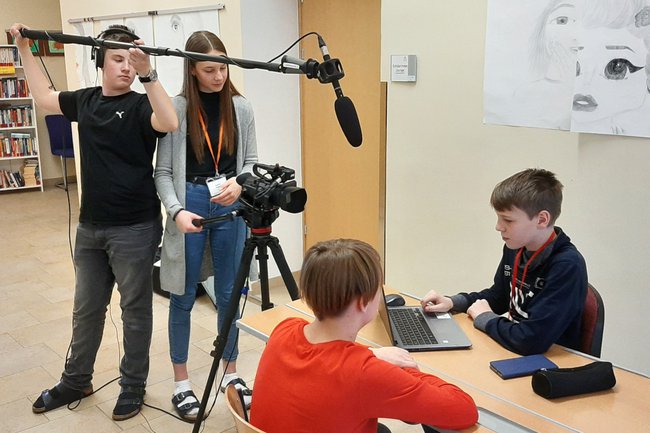Learning Tools for Digitalisation
Competence for the Confident Handling of New Media

Two sides of the same coin: staying connected with friends during the lockdown, participating in distance learning, and immersing oneself in exciting virtual media worlds – or fake news, cyber mobbing, smart phone and internet addiction, and a photo on the web that may ruin a job interview later. The opportunities offered by digitalisation and social media are as numerous as the dangers they pose.
In the project “DigGes – Gemeinsam in der digitalen Gesellschaft“ (Together in the digital society), school pupils developed digital learning and teaching materials on the topic of digitalisation together with educators and researchers. Their results are designed to help other young people improve their media skills and adopt a responsible and conscious approach to this matter.
Using Digitalisation with Media Literacy
The citizen science research project DigGes of the St. Pölten University of Applied Sciences dedicated itself to teaching children and teenagers the competent handling of different media in times of digitalisation. As part of the digital society, young people should be able to benefit from the chances and opportunities of digitalisation while avoiding their dangers and risks at the same time.
“It is important to discuss the manifold phenomena and implications of digitalisation in school education, ideally with the help of innovative teaching and learning materials developed not only for pupils but together with them. This project forged close links between technology and social sciences in dealing with digitalisation, which allowed us to promote media competence at various levels”, explains Astrid Ebner-Zarl, the head of the project and a member of the Media Business research group of the Institute of Creative\Media/Technologies (IC\M/T) at the St. Pölten UAS.
Developed by School Pupils for School Pupils
The project team created a total of 14 videos and two Kahoot quizzes dealing with digitalisation in an age-appropriate manner and tailored to the needs of the target group. This allows the learning materials to actually convey their important messages on topics such as fake news, violence in the media, and cyber mobbing.
In the course of several workshops and hackathons, the pupils involved in the project developed technical skills, built upon existing learning materials and expanded them using their own videos and offers. The learning materials came from the initiatives “Ö1 macht Schule”, “Rat auf Draht”, eTapas and saferinternet.at and were collected in the Ministry of Education’s “Eduthek”. Since the beginning of February, the results and new teaching materials created throughout the project have also been available in the Eduthek as well as other platforms and can be used for a variety of purposes.
Empowerment, Sensitisation & Know-How
Another result of the research project in addition to the created learning materials is the realisation that the end product is not the only thing which is important when it comes to creating learning materials. The process of production is just as significant. “It was fascinating to observe the effects that the practical work in small groups had on the dynamics in class, and how the pupils acted, interacted and presented themselves”, says Ebner-Zarl.
According to the project head, this type of setting is particularly well-suited for the empowerment of girls in a media technology context: “This made the girls’ skills and knowledge so much more visible. This setting also benefitted pupils with special needs and allowed them to develop their full potential.”
Combining Research, Creative Work and the Promotion of Media Competence
Through participatory observation, the project had the additional dimension of examining experiences of children and teenagers with social media and their handling of online risks.
“A key strength of our project lies in the close ties between research, creative work and the concrete promotion of media skills”, emphasises Ebner-Zarl who explains that media competence is taught at three different levels at once: outwards (for future users of learning materials), inwards (for the participating pupils), and in the form of information, sensitisation and – for the participants – the acquisition of concrete skills, for example in dealing with media technology.
The research groups Media Business and Media Creation at the IC\M/T of the St. Pölten UAS carried out the project DigGes together with the UAS’ Service and Competence Centre for Innovative Teaching and Learning (SKILL).
Further information on the project:
The project was funded by the Innovationsstiftung Bildung/Public Science (innovation foundation for education/public science) of the OeAD GmbH (Austria’s Agency for Education and Internationalisation). Project partners were Private Neue Mittelschule Zwettl, Hertha Firnberg Schulen für Wirtschaft und Tourismus, and the Verein Digitale Bildungsgesellschaft.